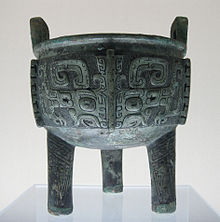
Back Ding (Gefäß) German Ding (vasija) Spanish Ding (chaudron) French דינג (כלי) HE Ding (wadah) ID Ding (vaso) Italian 鼎 Japanese 정 (용기) Korean Ding (naczynie) Polish Дин (сосуд) Russian
| Ding | |||||||||||||||||||||||||||||
|---|---|---|---|---|---|---|---|---|---|---|---|---|---|---|---|---|---|---|---|---|---|---|---|---|---|---|---|---|---|
 A ding from the late Shang dynasty | |||||||||||||||||||||||||||||
| Chinese | 鼎 | ||||||||||||||||||||||||||||
| |||||||||||||||||||||||||||||

Ding (Chinese: 鼎) are prehistoric and ancient Chinese cauldrons standing upon legs with a lid and two fancy facing handles. They are one of the most important shapes used in Chinese ritual bronzes. They were made in two shapes: round vessels with three legs and rectangular ones with four, the latter often called fāng dǐng "square ding (方鼎. They were used for cooking, storage, and ritual offerings to the gods or to ancestors.
The earliest recovered examples are pre-Shang ceramic ding at the Erlitou site,[1] but they are better known from the Chinese Bronze Age, particularly after the Zhou deemphasized the ritual use of huangjiu alcohol practiced by the Shang kings.[2] Under the Zhou, the ding and the privilege to perform the associated rituals became symbols of authority.[3] The number of permitted ding varied according to one's rank in the Chinese nobility: the Nine Ding of the Zhou kings were a symbol of their rule over all China but were lost by the first emperor, Shi Huangdi in the late 3rd century BCE.[4] Subsequently, imperial authority was represented by the Heirloom Seal of the Realm, carved out of the sacred Heshibi; it was lost at some point during the Five Dynasties after the collapse of the Tang.
- ^ Fong 1980, p. 2.
- ^ Chen, Jianming; Jay Xu; Fu Juliang (2011). Along the Yangzi River: Regional Culture of the Bronze Age from Hunan. New York: Art Media Resources, Ltd. pp. 23–24. ISBN 978-0-9774054-6-6.
- ^ Lawton, Thomas (1982). Chinese Art of the Warring States Period: Change and Continuity 480-222 B.C. Washington, D.C.: Smithsonian Institution Press. p. 23. ISBN 978-0-934686-39-6.
- ^ Food for Thought: Archeological Findings Point to Chinese Dietary Culture Archived 2007-02-04 at the Wayback Machine
© MMXXIII Rich X Search. We shall prevail. All rights reserved. Rich X Search